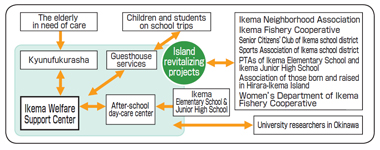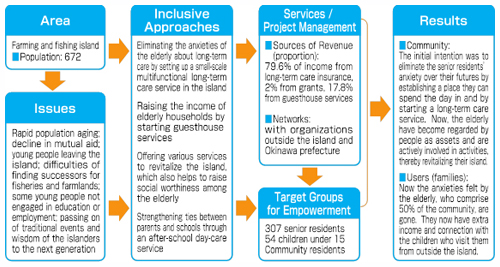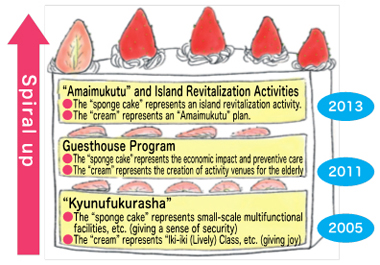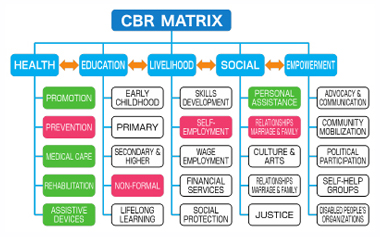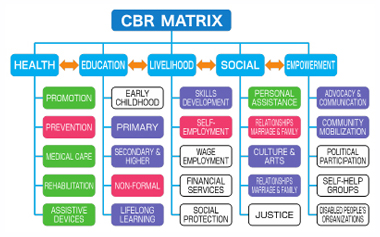Community-Based Inclusive Development
CBID Good Practices
Ikema Welfare Support Center (Specified Non-profit Organization)
(Miyakojima City, Okinawa Prefecture)
Key Words Aging Society, Resources of the Islands, Guesthouse Program
Ikema Island is 10 kilometers in circumference and located at the southwest of the main island of Okinawa. It is a small island with a population of 672, and is connected with Miyakojima Island with a bridge. About 50% of the residents are 65 years and older, and the island is regarded as a marginal village. Since there were no long-term care services before, once old persons became in need of care, they had to leave the island and were never able to return. In 2006 local housewives established a non-profit organization (NPO) and started a small-scale multifunctional center to provide home care for the elderly. This has enabled the elderly who need nursing care to continue to live in the island. More than that, this NPO also started a guesthouse service by using the homes of the elderly to give them social stimulation as well as extra income. Services such as this, participated in by the elderly, have begun to revitalize the local economy and the island as a whole.
◆Background
Ikema Island once flourished through bonito fishing and in 1980 had a population of 1,200. As fishing declined, its population rapidly decreased; and only 670 remain today. This is due to the outflow of young people, population aging and declining birthrate. The aging rate has reached 50%, but when long-term care services were no longer provided, older persons in need of long-term care had to leave the island. Despite the many problems, people in the community started to provide long-term home care services for the elderly to meet their needs within the community. Along the way they came to know other challenges their community was facing, which led to more services, thereby revitalizing the community.
◆Service Outline
A “Salon” for the elderly was created in 2003 and a survey was conducted to find out the needs of the elderly. The local housewives established the non-profit organization (NPO), Ikema Welfare Support Center. This NPO started “Kyunufukurasha” to provide long-term home-based care for the elderly, with a capacity good for 25 users (2006). Moreover, the same NPO also began a guesthouse service by using the homes of the elderly (2011). With financial support from Nippon Life Insurance Co., various services came to be offered, revitalizing the local community in which elderly residents are active participants.
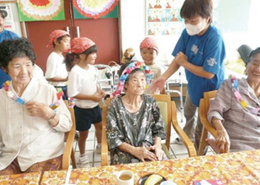
Interaction between the elderly and children
Basic Data
●Coverage Area: Hirara-Ikema, Miyako City, Okinawa Prefecture (fishing village)
●Population: 672 (as of March 2014)out of which 307 are 65 years and older; 54 are under 15 years old
●Issues: Increased need for long-term care due to population aging in the island. Decreasing population caused by exodus of young people causing succession problems in fisheries and farmlands. Some young people are not engaged in education or in work.
■Year of Establishment
Ikema Welfare Support Center, a non-profit organization, was created in 2004.
■Contents of Services
●Objectives: The original objective of the center was to provide long-term home-based care for the elderly living in Ikema Island, although the NPO has undertaken more endeavors to revitalize life on the island.
●Purpose of Services and Target Groups: This NPO started the “Kyunufukurasha” in 2006 to provide long-term home-based care for the elderly. Later, this NPO also started guesthouse services to give older people more social participation and worthiness and extra income. As their activities expanded to revitalize the whole island, the target group has become all the islanders, including school children.
●Stakeholders:
① Long-term home-based care services: Members and staff of the NPO, mainly housewives as well as elderly persons in need of long-term care.
② Guesthouse services: Elderly households offering the services, 4,000 children or more who have visited the island for school trips, and concerned citizens
③ Services to revitalize the island: Various organizations and island residents, including: neighborhood associations, fishery cooperatives, women’s associations, and parent-teacher associations (PTAs)
④ Some universities in Okinawa prefecture are sending student volunteers to Ikema Island and conduct research on the island’s unique strategy.
●Main Source of Revenue: Payment from the long-term care insurance, salary of the staff from the guesthouse services, and income from other services
●What We Have Implemented: Housewives set up a “Salon” for the elderly in 2003 in response to the dire need for long-term care services in the island. Having created a non-profit organization, Ikema Welfare Support Center, they opened “Kyunufukurasha” to provide long-term home-based care for the elderly with a capacity good for 25 users in 2006. While the long-term care services went well, there was an incident of an elderly person dying a solitary death. Realizing that long-term care services alone could not prevent incidents of solitary death, the NPO searched for a way to encourage the elderly to participate more in society. In 2011 they started a guesthouse service mainly by using the homes of the elderly, which contributed to an increase in the elderly’s household income. On the entire island, in just a span of 3 years, more than 4,000 students have come to stay for their school trips, which brought in more than 37 million yen worth of economic impact. Since there are some senior citizens who are not able to take part in the guesthouse service, the NPO has been implementing community revitalizing programs, with the financial support of 4 million yen from Nippon Life Insurance Co., so that many of them can participate in various ways, become more socially active.
■Special Features
■Power of local housewives
Housewives in their 40s, who had finished child raising, started taking the island’s problems seriously, as they keep hearing the elderly say, “Young people are abandoning our island.” Since Ikema Island had no hospital or long-term care facilities, when old people became sick or in need of long-term care, an increasing number of them left the island to live with their children, or moved to long-term care facilities in Miyako Island. Several local housewives started a “salon” for the elderly on a voluntary basis so that old residents would not spend the whole day at home and would be able to enjoy themselves. They conducted a survey by questionnaire to people 60 years and older, and many answered, “I want to spend time with friends during the day and go back to my own home in the evening. Even when I become sick, I wish to receive treatment on this island.” For those wishes to be granted, those housewives then planned to start a “small-scale, multifunctional, long-term home-based care service.” Thus, the initiatives of a few housewives, who were deeply concerned about the difficulties the island community was facing, led to a unique strategy for Ikema Island.
■Collecting the latest information and human resources
The housewives’ earnest wish, however, was not enough to start the long-term home-based care service. They began by first setting up an NPO as a framework for their activities, and then by renovating by themselves an abandoned building of the Japan Defense Agency. Before they began their long-term home-based care service, they utilized several information networks to collect the latest information regarding the conditions required to become a small-scale multifunctional long-term care service provider, and later successfully obtained a license from the city government. A care manager, indispensable in such services, was introduced by a network of the Tokyo metropolitan area. It was a housewife who enabled this NPO in the small remote island next to Miyakojima Island of Okinawa to acquire the latest information and much needed expertise. The representative of Ikema Welfare Support Center introduced an after-school day-care system in Miyakojima Island. By developing a network of contacts outside of the island and Okinawa prefecture, she was able to collect information, request an organization in Tokyo to conduct a survey on after-school day care in Miyakojima City, and eventually started a children’s day-care service. These networks of contacts she established were fully utilized to start this long-term home-based care service. The foregoing is an example that proves that, no matter how far a community is from major cities, one is still able to access the latest information and competent personnel.
■Implementing the PDCA (Plan-Do-Check-Act) Cycle (Spiral Up)
Four years have passed since the “Kyunufukurasha” was set up to meet the elderly's long-term care needs. It has gradually gained a reputation as being a reliable place for the elderly; however, in the summer of 2010, there was the first case of an old person who died a solitary death. This led to the next upward spiral cycle which began with the concept of creating a role for senior residents and to encourage them to have a greater participation in society. A guesthouse service for children was then planned and implemented. In 2011, eight elderly households initially started accepting students who visited the island for school trips. In the next 3 years, the number of homes used as guesthouses increased to 38, and the service has brought about a significant economic impact to the island.
However, there were many other issues the island was facing, such as the rapid aging of the community and decrease in population.
At this stage, it was clear that they needed the cooperation of the entire island community. Thus, to further revitalize their island, they initiated the 3rd upward spiral cycle. The island was blessed with the best and plentiful resource, called senior residents. From their wisdom called “Amaiumukutu,” they came to know some ancient foodstuff native to Ikema Island. One of them is “Utsumami,” a kind of bean grown from the time of the Ryukyu Dynasty. They are planning to revive the bean, and hope to sell it as a new local product. Other ideas for projects to revitalize the island include restoring the “Inuve” (wetland) and idle farmland, and a tree-planting campaign.
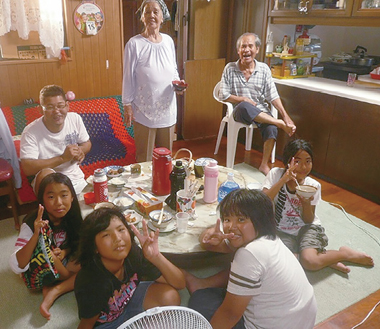
Happy time at a guesthouse
■Current lssues and Way Forward
Both long-term care services and guesthouse services are going well. The number of staff members working for this NPO is 27. Their main service is long-term care the income of which is used to pay the staff engaged in other activities. One staff member is hired for the Guesthouse Program. With the new after-school day care service starting, the target group is increasing. As for challenges with the guesthouse approach, when host families advance in age, the elderly couple find hosting guests in their home too much of a burden, and so start to decline offers. Since the target group of this project is elderly couples and not seniors living alone, this project’s expansion is limited to start with. A future challenge would be how to involve the youth of the island. It was thought earlier that young people would participate more if employment opportunities would increase, but it has not worked that well. Many of the staff members coming to live in this island recently are not originally from here. Like other island communities, Ikema has a problem of young people leaving the island, never to return. Even if they do return, often it is because they have problems and end up socially withdrawn. How to involve young people more in this island is the next big challenge.
Expanding after-school day-care services and strengthening ties with schools will be the next step forward. The people most active in the island revitalization project of “Amaimukutu” are elementary school children and junior high school students. It is hoped that these activities will nurture in children a love for their island so that they may return one day to live here.
◆How Things Changed
●Changes brought about by the small-scale multifunctional long-term home-based care service
As mentioned earlier, before this service began, once the elderly became in need of care, they had to leave the island. Thanks to the creation of the small-scale multifunctional long-term home-based care service, senior residents are now able to receive long-term care and continue living in this island, which is a significant development.
There have been some cases of elderly people, who once left the island to live in welfare facilities elsewhere, but have decided to return home. Since caregivers at “Kyunufukurasha” live in the community, they, as a community, can continue to monitor the elderly in need of care after they return home. This long-term care service has also created jobs for the local people. With this long-term care service, they have been able to employ 21 staff members and 6 part-timers, while creating opportunities to plan and implement other projects, too.
●Changes brought about by the Guesthouse Program
The impact of the Guesthouse Program has been significant. It started on June 2011, and until February 2014, some 4,087 students stayed (for 7,358 nights in total). This project generated revenue of 36.79 million yen for the island within these last 3 years. While this amount reflects direct income only, secondary economic effects from purchases made in the island could be equally high. The number of host families has increased to 43. This project has generated much extra income to elderly households that used to live on monthly pensions of about 30,000 yen.
Apart from the economic effects, other positive changes have taken place. At some elderly households, their children and/or grandchildren have come home to help with hosting visitors. So far, in 9 out of 43 households, their children returned home, and at 4 households their children have started coming back to help their parents temporarily when receiving guests. All these changes have strengthened family ties with those living outside the island, and these young people have started participating actively in activities in the island where they were born and raised.
■Analysis Using the CBR Matrix
◆When “Kyunufukurasha” was (2006~)
In the Matrix showing the situation when “Kyunufukurasha” was first created, it was first involved in the health sector, through its long-term care services, namely, Health Promotion, Healthcare, Rehabilitation, and Assistive Devices. Personal Assistance is also included (Long-term Care Service in Ikema). They are shown in green colors in the Matrix below.
◆When the Guesthouse Program was started (2011~)
Through the Guesthouse Program, the income of elderly households not only increased greatly (income generation), but it also helped them strengthen their relationships with their children/grand children who had left the island (relationships, marriage, family). This program encouraged the elderly to participate in the life of society, and contributed to disability prevention, too (prevention of the causes of disabilities). It enabled for ties between the elderly and the students who have stayed with them to be formed (non-formal education).
◆When Island Revitalization Programs started(2013~)
Learning about traditional culture, customs and festivals was revived (culture, arts), and in the field of empowerment, the elderly began taking initiatives in various activities. They include roles as “Island School Teachers” (lifelong education), handicrafts instructors (skills development), and cooking instructors for local cuisine (advocacy and communication). In addition, island revitalization endeavours contribute to a developing community, while providing after-school day care and teaching children traditional culture within the context of their elementary or secondary education.”
In the final analysis, we also realized that the CBR matrix used for persons with disabilities could be applicable as well as effective tools in analyzing community programs benefitting the elderly, children and the youth.

